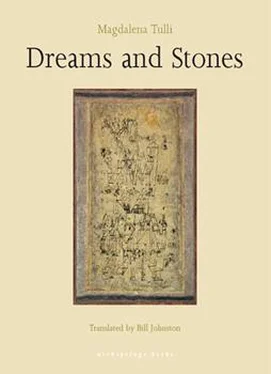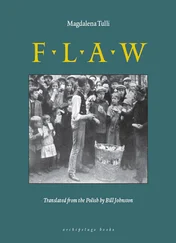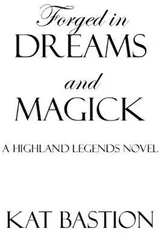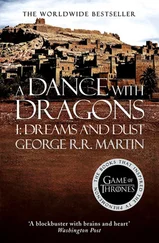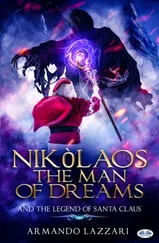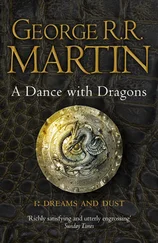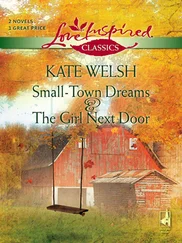Each of these places has its own central point that brings order to its space: It is a lottery office always for the same number game which in essence does not anticipate any winners. It is marked by a sign on which are painted symbols of good luck: a small skinny elephant above a frail four-leaf clover. Yet it is clear the elephant found the cloverleaf too late and is so weakened it cannot eat it. One feels sorry for the elephant because it missed its chance. Apparently somewhere at the furthermost branches of the tracks there live herds of large well-fed elephants that chew on clover — exclusively the four-leaf kind — every day of the week from morning to night till it makes them burp and they get hiccups in the shade of the palm trees. It is warm in both summer and winter where they are, whereas here there is rain and drizzle and dusk falls in the early afternoon. There in that mild climate it is said life is less arduous and death too is easier. An influence of those far-off regions that is hard to explain causes the space around the lottery offices to be distorted and disturbs the arrangement of thoughts as if they were iron filings obedient to the poles of a magnetic field. The contemplation of distant countries leads to serious illness (a trembling of the head and disturbances of vision brought on by a dull pain). Over the magnificent ebb and flow of a storm-whipped sea the color of bottle glass there rise warehouses of corrugated metal, cold landscapes set in window frames. The corrugated metal rises amid weeds; a fly lies upside down in the foreground.
Empty bottles hit passing trains, shatter and remain forever on the embankment, like a testimonial to the mysterious hatred felt by those regions toward anything that moves on tracks: The hatred felt by that which must always stay where it is toward that which — not fastened to the earth — escapes and disappears beyond the horizon.
And yet the tracks, wherever they lead, never forsake the expansive territories of the name even when they pass station buildings bearing innumerable foreign-sounding names such as Radom, Kielce or Kutno painted in black against a white background. Even when they pass through stations with the same names shining in bright colors over gray platforms. The lines of the tracks with their metallic gleam cut straight as arrows across a background black and white like a photograph: Even the wall of red brick has no trace of red in it. They do not attach themselves to any background or to any hue. They glint equally coldly amid fabulously colorful advertising posters, thrown-away illustrated magazines and empty soda cans. It is said that whoever does not know Kutno does not know life. In reality no one knows Kutno and no one ever can know it. The spaces of the name are filled with endless tracks next to which cities form briefly and only when needed and then vanish again immediately afterward like the red lights of semaphores in the gloom of dusk.
The last station turns imperceptibly into a seaport. There without even opening their eyes the passengers can transfer from trains to ships on which they will sail the seven seas. They will see massive whales and fearful icebergs and they will hear the song of sirens. The word Gdańsk shining over the platforms can be read as an allusion to a figure wielding a trident against a background of white clouds to the accompaniment of an audible signal. But it may prove only a fragment of a larger whole broken off from the words Free City Of. And it may equally well originate from newspaper headlines screaming in the tallest print that no one is willing to die for that name. It is only when its full content is revealed — in the platform sign it has been stintingly replaced with an ambiguous abbreviation — that the gravity of the reference can be comprehended. Yet amongst all the names that can be seen on station platforms there is not one for which the passengers would be prepared to die. The more so because no one knows whether it is possible to die in the same way that one sails the seven seas — without opening one’s eyes.
It is for this reason that the places whose names sound from station loudspeakers are incapable of independent existence, even though in many of these names varicolored lights are constantly being turned on and off and there are gigantic perfumed fountains and little silver bells that ring. Is it possible that Paris really exists — a place with a name so pretentious it makes one laugh? Or London, which was essentially conceived as fog? Manchester and Liverpool are two soccer fields with coal tips instead of stands. Bordeaux is a mountain in the shape of a bottle; Rotterdam, Antwerp and the Hague are the names of flea-ridden sailing ships rocking against the quay, their holds filled with spices and silk. Venice is in reality a mother-of-pearl gondola in which is concealed a music box. Chicago is a place filled with suitcases of money where gangsters in felt hats live, shoot guns and die. New York crammed the tallest skyscrapers in the world into an area six inches long and four and a half wide; on the other side there is a box for a postage stamp. Rome is a point to which all roads lead: a dusty moth-eaten inn in the middle of nowhere. The word Casablanca , white as paper and black as the night, is the name of a late-night bar for undecided suicides. All these are part of the city and if the truth be told, in it they occupy less room than a bookmark in a book. The passersby who gaze daily at the dim quadrilateral of Constitution Square understand that Paris is where one buys Parisian rolls and that no other Paris exists.
Apparently in Montevideo there is another Constitution Square with palm trees and a fountain in the middle, bathed in the blinding glare of the sun and ringed by colonial mansions. If something like this does exist it is only a supplement to the regular square that everyone knows, an additional hidden aspect of it that escapes everyday attention and does not belong in everyday consciousness. Apparently Milan also has a Central Station in the form of an immense sarcophagus from whose walls stone gargoyles stare down with bulging eyes and bared fangs. This means that for some reason the glass-walled Central Station in the middle of the city needs a more distinct shadow than that cast by its transparent sides. Apparently a Prague of gilded palaces hovers somewhere over the Praga neighborhood of shabby apartment buildings and courtyards deep as wells, cut off from the rest of the city by a river that tastes of rust and engine oil and from the sky of stars by a mantle of clouds and smoke. The buildings, streets and districts are suffocating from opportunities unrealized, transformations uncompleted, promises withdrawn and desires in abeyance for which the city searches in vain for an outlet. In the densely built-up space the city landscapes crowd together; the crush of them oversteps all bounds. It is precisely because of the pressure of missed possibilities that the city begins to generate mirages: the gold of Prague, the mystery of Milan, the colonial architecture of Montevideo.
The Central Station here — the only one that really exists — is one of the principal stops on the routes of the trams as they calmly transport their numbers from one terminus to the other. Hurrying to catch a tram one passes the platforms indifferently since the station is merely an underground passage and a transfer point for the municipal transit system. There are those who are reminded by the sight of the glass walls of when they once bought tickets for a train in the great light-filled hall. But they are well aware that at that time they were dreaming. This magnificent aquarium has no need for platforms or trains; it can exist equally well without them. Nor does it need tram stops or underground walkways. In essence it needs nothing. It is the city’s salvation.
Читать дальше
